Gold
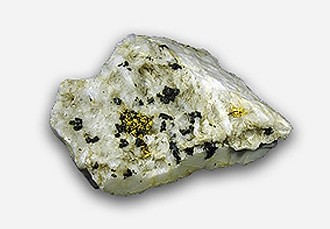 Victoria is a world-renowned gold province with a variety of deposit styles and world-class pre-competitive geoscientific data and knowledge to improve targeting and reduce mineral exploration risk.
Victoria is a world-renowned gold province with a variety of deposit styles and world-class pre-competitive geoscientific data and knowledge to improve targeting and reduce mineral exploration risk.
The world-class central Victoria gold province has produced >2,500 tonnes (~80 million ounces) of gold. Most deposits are classified as orogenic gold deposits that formed during regional deformation and metamorphism in the Late Ordovician to Silurian or in the Late Devonian.
Current production
Gold production and exploration expenditure remain buoyant. Production in Victoria is currently in the order of approximately 650,000 ounces of gold per annum, coming mainly from the world-class Fosterville deposit, Ballarat, Costerfield and Stawell.
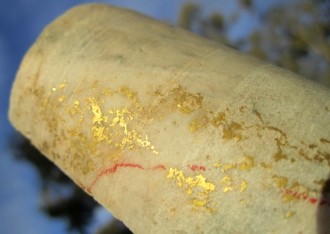 Victoria has thirteen goldfields that have each produced more than one million ounces (Moz) of gold. Bendigo (22 Moz) is the largest goldfield, followed by Ballarat, Castlemaine, Stawell and Woods Point-Walhalla with a growing production profile and resource base at Fosterville. Many Victorian goldfields offer opportunities for new discoveries through the application of modern geoscience knowledge and minerals exploration techniques and technology.
Victoria has thirteen goldfields that have each produced more than one million ounces (Moz) of gold. Bendigo (22 Moz) is the largest goldfield, followed by Ballarat, Castlemaine, Stawell and Woods Point-Walhalla with a growing production profile and resource base at Fosterville. Many Victorian goldfields offer opportunities for new discoveries through the application of modern geoscience knowledge and minerals exploration techniques and technology.
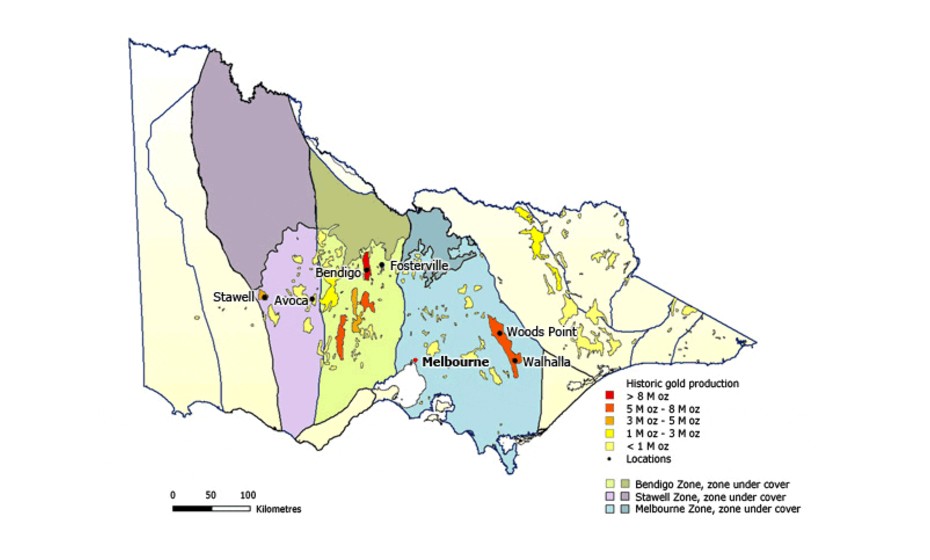
Gold deposits in Victoria
There are several types of gold deposits occurring in different geological settings across Victoria including: orogenic gold, volcanic-hosted massive sulphide deposits, intrusion-related gold, and alluvial gold.
Victoria hosts one of the world's largest orogenic gold provinces. Orogenic gold deposits represent by far the most economically important primary gold mineralisation in Victoria, accounting for almost all primary gold production (more than 1100 tonnes) and include most of the known and potential resources.
- Most of these deposits are in folded, faulted and regionally metamorphosed (commonly to greenschist facies) Cambrian to Devonian turbidites. They are found less commonly in Cambrian metavolcanic and sedimentary rocks and also in Devonian dykes.
- Mineralisation is associated with the late stages of regional deformation or in periods of reactivation of older structures. The timing, character and intensity of orogenic old mineralisation vary considerably in Victoria and bear a close relationship to the geological history of the known structural zones of the State.
- Orogenic gold deposits have been separated into mesozonal and epizonal mineralisation on the basis of the depth and temperature of gold deposition.
Mesozonal orogenic gold
Mesozonal orogenic gold was the main source of historical primary gold production and also the predominant original source of gold in alluvial deposits. They are most abundant in the Bendigo and Stawell structural zones and in the Walhalla Woods Point belt in the eastern Melbourne Zone.
- The Victorian goldfields of this type that produced more than one million ounces (31 tonnes) of gold from quartz veins include Bendigo (560 tonnes), Stawell (125 tonnes), Ballarat (88 tonnes), Walhalla (68 tonnes), Maldon (56 tonnes), Woods Point (40 tonnes) and Clunes (37 tonnes).
- Mesozonal orogenic gold is found in quartz veins that occupy dilational zones in fault sand at fold axes. These are known as saddle reefs and trough reefs. Most of the mineralised faults are reverse faults, and most are related to folding and characterised by fault displacements of less than 100 metres.
- Some individual quartz veins are more than 20 metres wide and can be traced for many hundreds of metres both horizontally and vertically. Gold-bearing quartz veins are often grouped into vein systems, which can cover areas of up to 150 square kilometres.
- Mineralised areas such as these may contain more than 100 tonnes of gold, with typical grades for current large-scale underground mining between 5 and 30 g/t(grams of gold per tonne of ore).
- The quartz veins that host mesozonal orogenic gold commonly contain minor amounts of ferromagnesian carbonates and a few percent of sulphides, although in eastern Victoria the sulphides may be the dominant ore mineral. The sulphides are mostly pyrite and (in some cases pyrrhotite and arsenopyrite), with smaller amounts of chalcopyrite, sphalerite and galena. Native gold is found as both free grains and submicroscopic inclusions in sulphides.
- The mineralogy and geochemistry of the gold mineralisation show broad regional variations. The fineness [1000 × gold/(gold + silver)] of most mesozonal orogenic gold is greater than 920, but in the Stawell Zone it is commonly less than 750 and occasionally less than 300.
- Mesozonal orogenic gold was precipitated from low-salinity fluids at depths of six to twelve kilometre sand at temperatures between 300°C and 475°C. The main phase of mesozonal orogenic mineralisation in the Bendigo and Stawell zones occurred at around 440 million years ago (440 Ma) and that in the Melbourne Zone at around 380 Ma.
Epizonal orogenic gold
Epizonal orogenic gold mineralisation forms by precipitation of gold from low-salinity fluids at depths of two to six kilometres and temperatures between 170°C and 300°C. These types of deposit are most common in the western part of the Melbourne Zone and in the eastern Bendigo Zone. Most individual deposits are small.
- The only major known ore field of this type in Victoria is the Fosterville goldfield (at least 65 tonnes total gold) in the Bendigo Zone. Other epizonal orogenic deposits including Costerfield, Nagambie, Heathcote and Bailieston contained less than 10 tonnes of gold. Typical grades for underground mining vary between 5 and 15 g/t gold.
- Epizonal orogenic gold deposits characteristically contain submicroscopic inclusions of gold in sulphides within quartz sulphide veins and in stockworks in faults. Free gold is rarely found in unoxidised ores and gold may also be present as aurostibite (AuSb2).
- The dominant sulphides in epizonal orogenic gold deposits are usually arsenopyrite, pyrite and stibnite. The mineralogy of ores changes according to the temperature of gold deposition. Assemblages dominated by arsenopyrite and pyrite were deposited at higher temperatures (e.g. Fosterville gold mine) than ores with stibnite as the dominant sulphide (e.g. Costerfield gold mine).
- In Victoria, these deposits are believed to have formed at around 380 Ma but because of their low temperature of formation, the precise ages of the deposits in the Bendigo Zone are unclear. Those in the Melbourne Zone were deposited immediately after the Tabberabberan deformation at 380 Ma, the only major deformation to have affected the zone.
Elevated gold occurs in some of the few known VHMS deposits in Victoria.
The best-known examples are the Currawong copper zinc deposit (9.5 million tonnes of ore) in the Omeo Zone and the Mount Ararat copper deposit (1 million tonnes of ore) in the Stawell Zone.
Gold in these deposits is associated with pyrite, chalcopyrite and sphalerite at grades of between 0.5 and 2 g/t.
Several small intrusion-related gold deposits have been identified in Victoria. These are spatially and temporally related to felsic intrusions, have characteristic geochemistry and formed later than other styles of gold mineralisation in Victoria. Unlike the orogenic gold deposits, they were deposited a considerable time after the main local orogenic phase.
- The Wonga deposit at Stawell (~10 tonnes of gold) is the largest intrusion-related deposit in Victoria. There are historical workings associated with some intrusion-related occurrences (e.g. Mount Moliagul) while there are several other prospects throughout the state.
- Gold in intrusion-related deposits is in quartz veins that also contain minor amounts of sulphides. These deposits commonly have anomalous concentrations of molybdenum,tungsten, bismuth, antimony, copper, tellurium, and sometimes tin, boron and fluorine.
- The magmatic source for intrusion-related deposits is unclear. In particular, deposits hosted by metaturbidites and characterised by gold values exceeding 30 g/t (up to 510 g/t) share many attributes with some orogenic gold deposits.
- Most intrusion-related occurrences formed at around 370 to 380 Ma in the Melbourne and eastern Bendigo zones, forming at 400 to 420 Ma elsewhere in the state.
Alluvial deposits in Victoria were formed by weathering and erosion of primary gold mineralisation. The largest alluvial deposits are typically close to major orogenic gold deposits (e.g. Ballarat, Bendigo and Castlemaine). However, several major alluvial goldfields are in areas where only trivial primary gold deposits are known (e.g. Creswick, Chiltern, Ararat and Beaufort).
- Total Victorian alluvial gold production is estimated to be about 1500 tonnes but historical records are poor or non-existent, so there is uncertainty about this number. The largest alluvial goldfields extended over distances of around 10 kilometres and produced more than 100 tonnes of gold.
- Most alluvial deposits were traced to their primary sources, and thus led to primary gold mineralisation. To date, no significant primary deposits that have been mined in Victoria have been found by other means.
- Most alluvial gold in Victoria is hosted in Eocene to Holocene gravels, including ridge-forming cemented gravels. The grain size of alluvial gold varies both within and between deposits and is probably related to properties of the primary source mineralisation. Some areas in central and western Victoria are well known for an abundance of gold nuggets.
Exploration and development opportunities
Victoria’s gold prospectivity (potential) is significant for gold, is based on a long history of production and the presence of large, under-explored but highly prospective areas, including greenfields areas beneath shallow cover. For example, simulations by the Geological Survey of Victoria suggest that there may be up to 75 million ounces of gold still to be found in the northern parts of the Stawell, Bendigo and Melbourne zones, including multiple million-ounce occurrences.
Victoria’s gold deposits are often high-grade and offer the potential for clustered, small-footprint operations. Victoria features access to high quality transport and utilities infrastructure, established global markets and export pathways and boasts a highly skilled, local workforce. Melbourne is a global mining hub and corporate home to many large mining and mining services companies and a thriving mining, equipment, technology and services sector.
Victoria also features world class publicly available pre-competitive geoscientific data and knowledge to improve mineral exploration targeting, including from the Geological Survey of Victoria’s Gold Undercover initiative and open-file minerals exploration data.
Gold Undercover
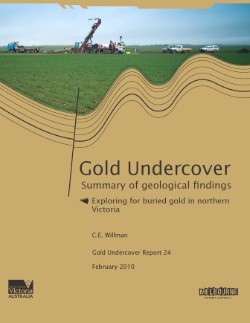 The Gold Undercover Initiative was a three-year applied geoscience research program (2006-2009) to provide new data and to improve mineral exploration in gold-bearing Palaeozoic basement rocks that are buried beneath Cainozoic sediments of the Murray Basin in the Stawell, Bendigo and Melbourne structural zones of northern Victoria.
The Gold Undercover Initiative was a three-year applied geoscience research program (2006-2009) to provide new data and to improve mineral exploration in gold-bearing Palaeozoic basement rocks that are buried beneath Cainozoic sediments of the Murray Basin in the Stawell, Bendigo and Melbourne structural zones of northern Victoria.
The Initiative included multiple geoscience studies and literature reviews resulting in a comprehensive set of publications comprising; twenty-four Gold Undercover reports and two peer reviewed papers published in Australian and international scientific journals.
Read the Gold undercover report series.
A deeper understanding of Victorian gold
Earth Echoes is a short film that documents a major project by the Geological Survey of Victoria and collaborative partners in which deep 2D seismic reflection data was acquired along a 400 kilometre transect across central Victoria in 2006. The resulting geological interpretation models have increased confidence in Victoria’s geological architecture, including controls on orogenic gold mineralisation and considerations for mineral exploration targeting in central Victoria.
Watch the Earth Echoes short film.
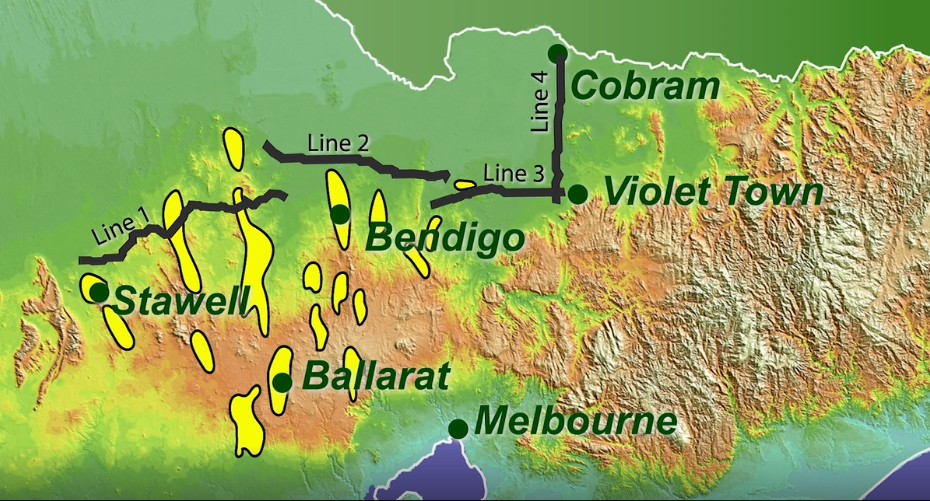
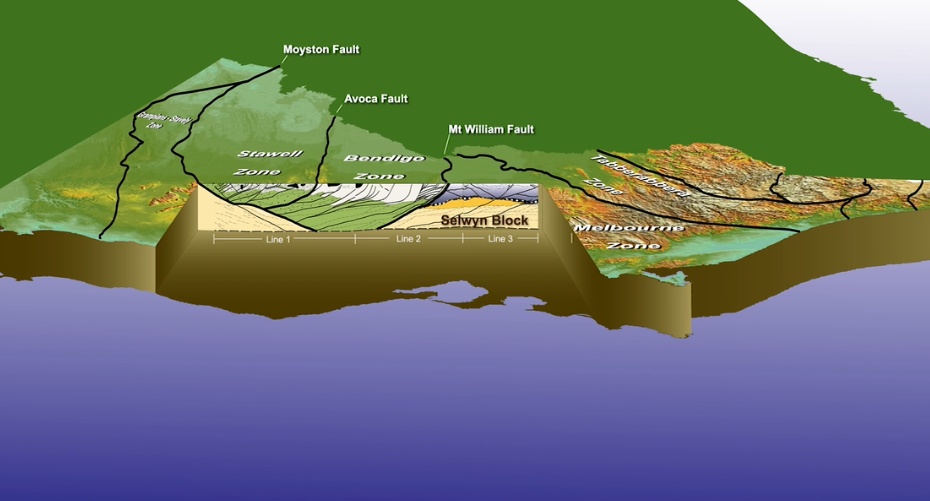
Did you know...
New tectonic and geodynamic models developed for southeast Australia by the Geological Survey of Victoria offer different geological correlations to previous interpretations and reveal new orogenic gold opportunities in Victoria.
- Download GSV presentation notes: Gold in Victoria - the current state of play (PDF - 7.1 MB)
Recreational prospecting and fossicking
Looking for gems and minerals, such as gold, can be done using metal detectors or pans. To fossick in Victoria, you need a current fossicking permit known as a miner's right.
Find out where you can prospect and fossick in Victoria.
More gold information
Page last updated: 01 Dec 2021